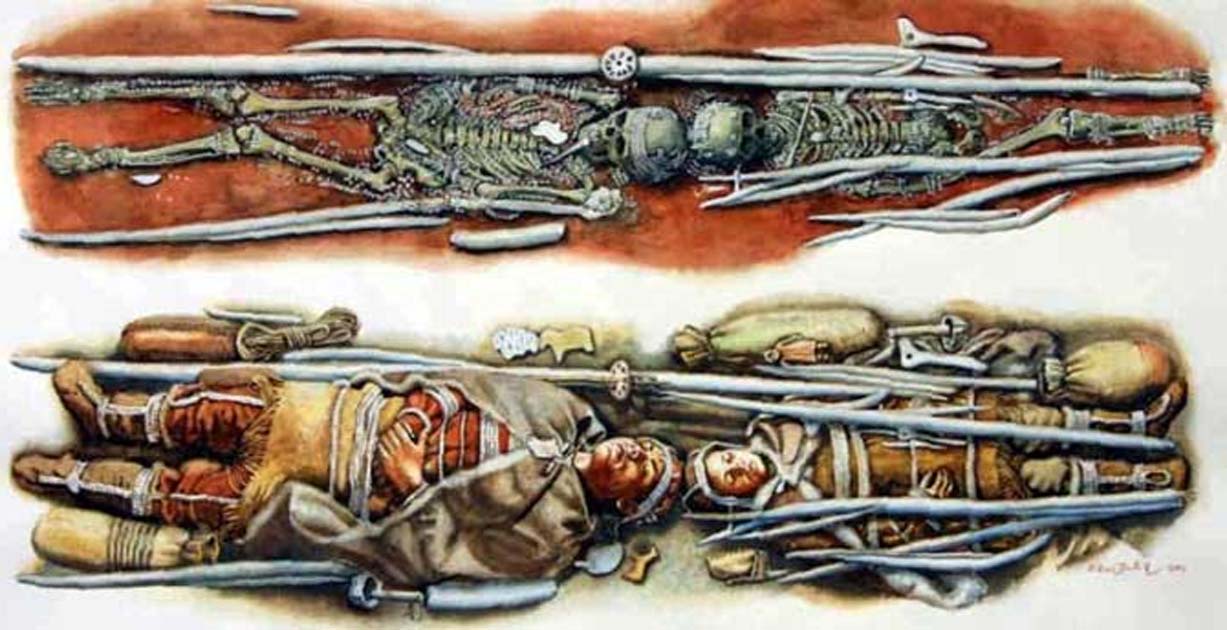Mammoth Tears of Compassion Sealed A 34,000-Year-Old Children’s Grave
About 34,000 years ago, two physically challenged boys were buried head to head, with tens of thousands of animal bone offerings, according to a Cambridge Journal of Antiquity paper published last week.
Known as the Sunghir burial it was discovered on the northeast outskirts of Vladimir, Russia, and excavated between 1957 to 1977, as was reported in a LiveScience article this week. Belonging to hunter gatherers who lived in the Mid Upper Paleolithic, about 34,000 years ago, the grave site held 10 men and women “but the two boys have, by far, the most spectacular riches,” the researchers said.
Differential Burials
The two boys, roughly 10 and 12 years old, had “physical conditions,” yet they were buried “head to head in a long, slender grave with 10,000 mammoth ivory beads, 20 armbands, about 300 pierced fox teeth, 16 ivory mammoth spears, carved artwork, deer antlers and two human fibulas (calf bones) laid across the boys' chests,” the researchers reported.
A roughly 40 year old man with no physical disabilities was also discovered, therefore he was ‘able’ and would have contributed to the group, yet was buried with only “3,000 mammoth ivory beads, 12 pierced fox canines, 25 mammoth ivory arm bands and a stone pendant,” a fact which confuses researchers as it was commonly thought that only active contributors to hunter societies would have been ritually buried in this way.
- The Sunghir Burial Site: Were these Two Children Sacrificed in a Form of Prehistoric Scapegoating?
- Prehistoric Humans are Likely to Have Formed Sex Networks to Avoid Inbreeding

Man in an Upper Paleolithic burial in Sunghir, Russia. (Public Domain)
Atypical Lives
Both of the Sunghir boys had “experienced repeated periods of extreme stress,” according to an analysis of their dental enamel, the researchers reported. And what’s more, the younger of the two boy's thighbones were "exceptionally bowed and short.” Meanwhile, an analysis of the 12 year old’s skeleton indicated that he was bedridden from birth and because his “teeth had almost no wear,” researcher Trinkaus said “it’s possible the group was feeding the 12-year-old boy soft foods, such as porridge.”
- Did Man and Mammoth Ever Live in Harmony? Not Quite…
- Dismembered Remains Tell Horrifying Tale of Ritual Human Sacrifice in Ancient Crete

Reconstruction of what the children in the Sunghir double burial may have looked like. ( wowavostok)
A Highly Privileged Burial
The researchers were baffled with the diversity and volume of burial artifacts found with the children, as some people in the burial site were interred with “only a few fox canines and mammoth ivory beads,” while other individuals didn't have anything. Because people were treated differently in death “this indicates social complexity,” Trinkaus said. This seems likely, and others have argued that the children may have been part of a ritual sacrifice, as is explored in an Ancient Origins article by Caleb Strom.
The LiveScience article quoted Dr Lawrence Straus, a distinguished professor emeritus of anthropology at the University of New Mexico who pointed out that the find shows that in Mid Upper Paleolithic you didn’t have to be a "big, adult male hunter" to get an extravagant burial. “In this case, adolescents with disabilities or pathologies that would have limited their full functioning are getting some amazing treatment,” Straus told Live Science.
- New study shows brain-damaged child was well cared for 100,000 years ago
- Invisible Killers - Poisons may have been used by Palaeolithic society 30,000 years ago, new testing shows

Healthy Paleolithic hunter. (CC0)
Community Care
Healthcare in prehistory was studied in a 2006 New York Times feature entitled Ancient Bones That Tell a Story of Compassion, in which Dr. Buikstra, director of the Center for Bioarchaeological Research, who concentrates on the co-evolution of humans and their diseases, said that “People have from time to time across the years tried to attribute caring, and caring for, to ancient people.” And finally, Dr. Buikstra offers us a word of caution saying “getting into the minds of ancient people is always difficult and we must be careful not to evaluate health in the ancient world against our care needs for severely disabled people.”
It could be said that Dr. Buikstra was being a little dry, and although she had a valid point, in urging us to show caution as to how we interpret how prehistoric disabled children were treated, she cannot deny that the 12 year old child in the Sunghir burial, bedridden with no signs of tooth wearing, didn’t mix his own porridge, defend himself from predators and pull himself across the ancient landscapes collecting and preparing food. Someone, for sure, cared for him. And finding 10’s of thousands of carefully crafted grave offerings, the most open minded of us might even venture to suggest that the child was loved.
Top image: The skeletons and a depiction of what the grave may have originally looked like. ( Libor Balák )
By Ashley Cowie

















